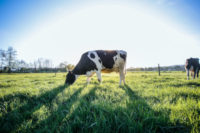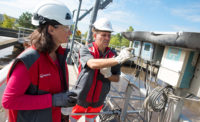Taking steps to manage sustainability along the supply chain makes good business sense for dairy processors. Indeed, 2018 research by The Nielsen Co. LLC, New York, reveals that 81% of global consumers and 69% of those in the United States say that it’s very important or extremely important that companies implement programs to help the environment.
“The passion for corporate social responsibility is shared across gender lines and generations,” Nielsen states. “Millennials, Gen Z and Gen X are the most supportive, but their older counterparts aren’t far behind.”
Attracting such buyers and creating a reputation for having a sustainability mindset will better enable operators to stand out in an increasingly eco-conscious environment.
“Consumers are exerting pressure on dairy companies to embrace sustainability in their values, product offerings, and practices,” says Sheri Cole, assistant professor of practice — dairy extension and sustainable food manufacturing at Oregon State University in Corvallis. “Those who do this authentically and well gain revenue growth and consumer loyalty.”
She notes that there is a “clear linkage between an improved environmental footprint and financial performance. Waste in energy, water management, in-process materials or end-of-lifecycle product management costs money.”
The payback from sustainable practices is making it more enticing for dairy operators to leverage and encourage supply chain partners to follow the proper measures, analysts state.
“While the consumer-topical perspective is to ‘save the environment,’ there is a real dollar value to sustainability and waste elimination in supply chains,” says Glenn Emory, general manager — North America for Weidenhammer New Packaging LLC, a Kansas City, Mo.-based packaging material and equipment firm. “The perspective has to change from one of ‘sustainable’ being a new subcategory to one of being the new standard and not through green-washing of products and services.”
Operators seeking sustainable systems should seek out “pathways” of change rather than a specific solution, Emory says.
“The area of sustainable solutions is so dynamic that companies first need to make the pivot on pathways, knowing the ultimate solution is likely to be different in manifestation than what may be known at the outset,” he states.
Along with reducing energy and water consumption across the supply chain, sustainable opportunities include rethinking packaging from design to post-consumption and creating dairy products that deliver meaningful health benefits, Cole says.
“Leading global food companies have set aggressive environmental commitments such as carbon neutrality, water, and energy use reductions, and zero waste,” adds Lisa Watson, social responsibility officer for the Rosemont, Ill.-based Innovation Center for U.S. Dairy. “These companies are also requiring their suppliers to show progress and report comprehensively on sustainability metrics.”
Sustainability is not simple

Reusable containers that require less washing and sanitizing are likely to appeal to eco-conscious operators. Photo courtesy of Schoeller Allibert U.S.
In addition, implementing sustainability measures can be capital-intensive, Watson says.
“Although sustainability investments may present a net savings over the course of 10 to 20 years, the initial financial hurdle is often difficult to overcome, thus hindering rapid progress.”
Emory adds that while the dairy sector has “a legacy of regulation that has helped create the industry of today,” that also acts as an impediment to adopting novel measures, which include sustainable objectives. It can be particularly difficult for supply chain partners to implement sustainable methodologies that result in products with higher prices, less consistency, a short shelf life, and seasonal availability, he says.
“If the consumer balks [at] buying products produced with more sustainable ingredients or processes, then processors will naturally revert to methods of today,” Emory states. But “on many items, the consumer will come around with increased exposure and education. There is an emotional desire that cannot be denied.”
A shortage of supply chain talent can further slow the incorporation of sustainable measures, says David Closs, John H. McConnell, chair emeritus and former chairperson of the Department of Supply Chain Management in the Eli Broad College of Business at Michigan State University in East Lansing.
“When I talk about trends in supply chain management with executives, historically their No. 2 is talent, but today it is No. 1,” he says. “It is hard to run an efficient operation if you don’t have the talent to do it. … There is not a clear remedy and it is getting worse because people in other businesses are hiring supply chain talent. If you do not have good talent, you are not going to have a sustainable operation.”
Cole notes that dairy stakeholders are piloting ways to engage middle school and high school students (potential future employees) via career technical education programs and more. Organizations also are investing significantly in university scholarships and research such as Build Dairy, a Western region program consisting of business leaders, researchers, educators and students who are focusing on building a more sustainable dairy sector.
“The industry must have a robust talent pipeline by being the destination of choice for the best and the brightest students, who will create and manage the industry of the future across the dairy system,” Cole says.
Other supply chain trends, meanwhile, are having both positive and detrimental impacts on sustainability, Closs says. More grocery operators, for instance, are seeking suppliers with nearby plants to reduce fuel consumption during transit and delivery times.
“Retailers, and particularly grocery stores, are looking for the ability to say ‘We are an environmental operation and we get fresher food from closer suppliers,’” he states. “They want to work with suppliers who can help them do that.”
The increasing number of dairy product SKUs, however, especially for yogurt, is resulting in the need for additional and different packaging materials and frequent line changeovers during production, which negatively influences economies of scale and leads to waste, Closs says.
“Having more variation costs more to produce,” he says.
Narrow the focus

Dairy processors that focus on sustainability are in a position to reduce activity at wastewater treatment facilities.Photo courtesy of the Innovation Center for U.S. Dairy
Pat Cici, marketing manager/Western region sales for Schoeller Allibert U.S., a Goodyear, Ariz.-based container manufacturer, says operators can benefit by transitioning from one-way containers to reusable because the items often require less washing and sanitizing.
He notes that reusable containers can have a “bag-in-box” system in which a liner bag in the container holds the product. End users then remove and recycle the liner bag and return the container, which often requires little or no washing, back to the processor. Despite a higher initial outlay, the cost savings from reusables will, over time, greatly exceed the expense of regularly purchasing one-way containers, CiCi says.
Having the technologies to efficiently collect operational information will further enable processors to enhance their sustainable operations, analysts note.
“We are good as an industry in terms of having quality data on productivity, yields, and product quality,” says David Darr, chief strategy and sustainability officer for Kansas City, Kan.-based Dairy Farmers of America, “We are not as far along in terms of utilizing data the same way as it relates to energy consumption or water usage or waste streams.”
In a nutshell, it’s about having the tools, analytics, and information to recognize where you have problems, and then understanding what is causing those issues and how to eliminate them, says Jack Payne, solution consulting director for food and beverage at Aptean, an Alpharetta, Ga-based based provider of dairy management software. The proper technologies will enable processors to identify where they are experiencing losses in terms of sustainability and waste so they can best address those issues, he says.
“One of the biggest challenges is not having the digital foundation and the right business systems to collect the data in real-time and leverage it for analytics,” Payne says, which results in processors spending too much time gathering data and not enough time determining what operational changes are necessary.
The future is now

Anaerobic digesters break down biodegradable material in the absence of oxygen and use the biogas to generate electricity and heat. Photo courtesy of the Innovation Center for U.S. Dairy
“We have strong commitments and engagements within the U.S. dairy industry on the importance of environmental sustainability across the dairy chain,” Darr says. “It will have a positive impact from an environmental perspective for farms, transportation, and processors.”
Yet supply chain partners still must remain flexible in their operating procedures if they are to incorporate effective sustainable measures, he says.
“Many plants are making different products in different parts of the country, and a one-size-fits-all approach to sustainability won’t work or be impactful,” Darr says. “We have to look at the specific opportunities, needs, and challenges of each facility.”
A focus on sustainability is “good for business,” he says. “There can be a positive impact on plant profitability when we bring a long-term focus on responsibly operating dairy facilities across the country and a commitment.”
While an embrace of sustainable measures by dairy processors and their supply chain partners is key to creating an eco-friendly halo, it also is important for the parties to effectively communicate their efforts to shoppers, Cole says.
“Consumers want to make good decisions for themselves and their families but are bombarded with information and have grown more skeptical about whom to trust to educate themselves,” she states. “Even as dairy makes meaningful strides in creating a sustainable supply chain, consumers must understand and trust our actions.”
Because implementing the optimal technologies can be challenging, the dairy industry will benefit from treating sustainability as a pre-competitive opportunity for companies to work together to create meaningful change, Cole says. That opportunity could include public-private collaborations and investments.
“It's essential that there are paths to support this work from a variety of sources and not just from within a given company,” she states.



